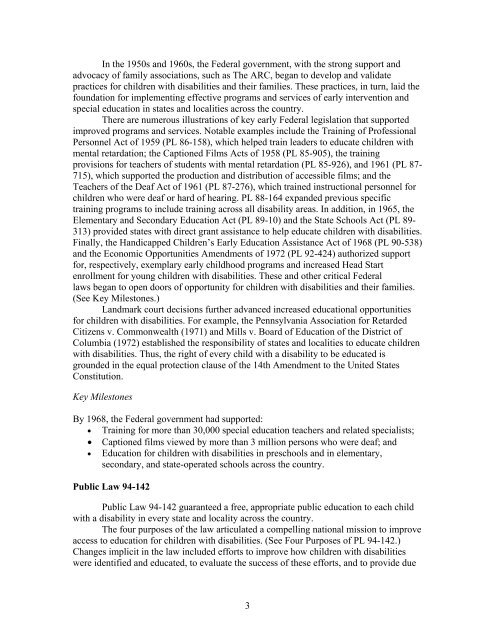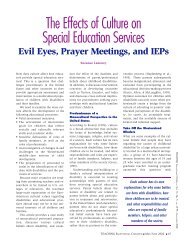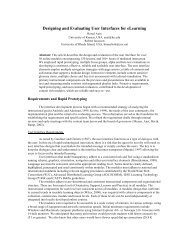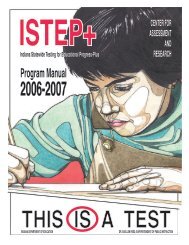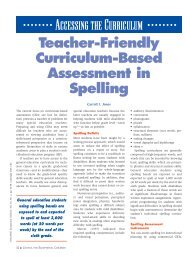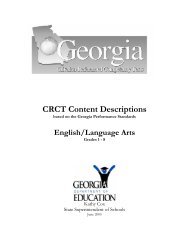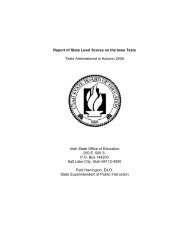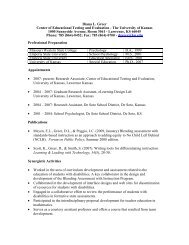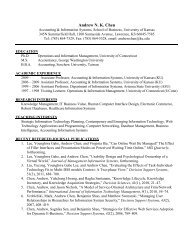Twenty-five years of progress in educating children with disabilities ...
Twenty-five years of progress in educating children with disabilities ...
Twenty-five years of progress in educating children with disabilities ...
You also want an ePaper? Increase the reach of your titles
YUMPU automatically turns print PDFs into web optimized ePapers that Google loves.
In the 1950s and 1960s, the Federal government, <strong>with</strong> the strong support and<br />
advocacy <strong>of</strong> family associations, such as The ARC, began to develop and validate<br />
practices for <strong>children</strong> <strong>with</strong> <strong>disabilities</strong> and their families. These practices, <strong>in</strong> turn, laid the<br />
foundation for implement<strong>in</strong>g effective programs and services <strong>of</strong> early <strong>in</strong>tervention and<br />
special education <strong>in</strong> states and localities across the country.<br />
There are numerous illustrations <strong>of</strong> key early Federal legislation that supported<br />
improved programs and services. Notable examples <strong>in</strong>clude the Tra<strong>in</strong><strong>in</strong>g <strong>of</strong> Pr<strong>of</strong>essional<br />
Personnel Act <strong>of</strong> 1959 (PL 86-158), which helped tra<strong>in</strong> leaders to educate <strong>children</strong> <strong>with</strong><br />
mental retardation; the Captioned Films Acts <strong>of</strong> 1958 (PL 85-905), the tra<strong>in</strong><strong>in</strong>g<br />
provisions for teachers <strong>of</strong> students <strong>with</strong> mental retardation (PL 85-926), and 1961 (PL 87-<br />
715), which supported the production and distribution <strong>of</strong> accessible films; and the<br />
Teachers <strong>of</strong> the Deaf Act <strong>of</strong> 1961 (PL 87-276), which tra<strong>in</strong>ed <strong>in</strong>structional personnel for<br />
<strong>children</strong> who were deaf or hard <strong>of</strong> hear<strong>in</strong>g. PL 88-164 expanded previous specific<br />
tra<strong>in</strong><strong>in</strong>g programs to <strong>in</strong>clude tra<strong>in</strong><strong>in</strong>g across all disability areas. In addition, <strong>in</strong> 1965, the<br />
Elementary and Secondary Education Act (PL 89-10) and the State Schools Act (PL 89-<br />
313) provided states <strong>with</strong> direct grant assistance to help educate <strong>children</strong> <strong>with</strong> <strong>disabilities</strong>.<br />
F<strong>in</strong>ally, the Handicapped Children’s Early Education Assistance Act <strong>of</strong> 1968 (PL 90-538)<br />
and the Economic Opportunities Amendments <strong>of</strong> 1972 (PL 92-424) authorized support<br />
for, respectively, exemplary early childhood programs and <strong>in</strong>creased Head Start<br />
enrollment for young <strong>children</strong> <strong>with</strong> <strong>disabilities</strong>. These and other critical Federal<br />
laws began to open doors <strong>of</strong> opportunity for <strong>children</strong> <strong>with</strong> <strong>disabilities</strong> and their families.<br />
(See Key Milestones.)<br />
Landmark court decisions further advanced <strong>in</strong>creased educational opportunities<br />
for <strong>children</strong> <strong>with</strong> <strong>disabilities</strong>. For example, the Pennsylvania Association for Retarded<br />
Citizens v. Commonwealth (1971) and Mills v. Board <strong>of</strong> Education <strong>of</strong> the District <strong>of</strong><br />
Columbia (1972) established the responsibility <strong>of</strong> states and localities to educate <strong>children</strong><br />
<strong>with</strong> <strong>disabilities</strong>. Thus, the right <strong>of</strong> every child <strong>with</strong> a disability to be educated is<br />
grounded <strong>in</strong> the equal protection clause <strong>of</strong> the 14th Amendment to the United States<br />
Constitution.<br />
Key Milestones<br />
By 1968, the Federal government had supported:<br />
• Tra<strong>in</strong><strong>in</strong>g for more than 30,000 special education teachers and related specialists;<br />
• Captioned films viewed by more than 3 million persons who were deaf; and<br />
• Education for <strong>children</strong> <strong>with</strong> <strong>disabilities</strong> <strong>in</strong> preschools and <strong>in</strong> elementary,<br />
secondary, and state-operated schools across the country.<br />
Public Law 94-142<br />
Public Law 94-142 guaranteed a free, appropriate public education to each child<br />
<strong>with</strong> a disability <strong>in</strong> every state and locality across the country.<br />
The four purposes <strong>of</strong> the law articulated a compell<strong>in</strong>g national mission to improve<br />
access to education for <strong>children</strong> <strong>with</strong> <strong>disabilities</strong>. (See Four Purposes <strong>of</strong> PL 94-142.)<br />
Changes implicit <strong>in</strong> the law <strong>in</strong>cluded efforts to improve how <strong>children</strong> <strong>with</strong> <strong>disabilities</strong><br />
were identified and educated, to evaluate the success <strong>of</strong> these efforts, and to provide due<br />
3


